It’s an understatement to say that the world couldn’t get enough of Korbut after the 1972 Olympics.
In fact, after the Munich Olympics, the Soviet team didn’t go home. They left immediately for a tour of West Germany, which upset Korbut. As she recalls her autobiography, My Story, she just wanted to go home:
So, after we had already done our best at the Olympics, expending our entire physical and emotional strength, we had to travel from one city to another for the next two weeks, sometimes performing as often as twice a day. We would have to use non-standard small apparatuses in small school gymnasiums, but that was the least of our problems. It was as though someone had gone up to Bob Beamon, the Olympic long-jump champion at Mexico City in 1968, right after he had jumped an incredible 29 ft 2½ in, and said, “Good job, Bob, you’ve done well. Now you have to jump again, for at least thirty feet this time.
The Sports Committee’s only interest was making more money, even if it was at the expense of our health and emotional well-being. We were like slave labor to them.
My Story
The touring didn’t stop there, and because Korbut was the biggest star on the team, the contracts reportedly demanded that Korbut participate in the tours — even when she didn’t want to. As Korbut tells it, she didn’t want to come to the United States, and Larisa Latynina, the head coach at the time, had to fetch her.
Once Korbut and the rest of the Soviet team made it to the United States, they performed around the country and made a trip to the White House to meet with President Nixon. Members of an unofficial Olga Korbut fan club greeted them everywhere, and Korbut appeared on the cover of Sports Illustrated.
If that weren’t tiring enough, a few months later, the Soviet team headed to Great Britain, where Korbut was the star, appearing on British billboards and headlining exhibitions.
Of course, there were detractors — those who didn’t think Korbut’s gymnastics was all it was cracked up to be. But their voices were largely outnumbered by far more enthusiastic ones.
In the following post, we’ll look at a small fraction of the Olga mania that swept the globe in 1973.
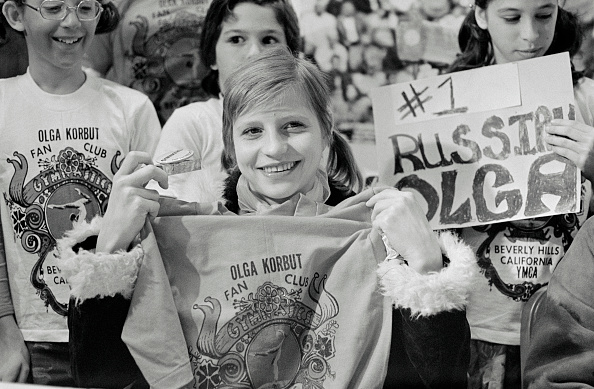
Quick Links: Fan Club | The Tour That Almost Wasn’t | The U.S. Tour (Video) | At the White House | Touring London (Video)
The Korbut Fan Club
Gymnast, which would later become International Gymnast, ran an Olga Korbut fan club that started at the Beverly Hills YMCA. Members got a lot of paraphernalia for their $5.00 membership fee. Here’s an ad that ran in the magazine:
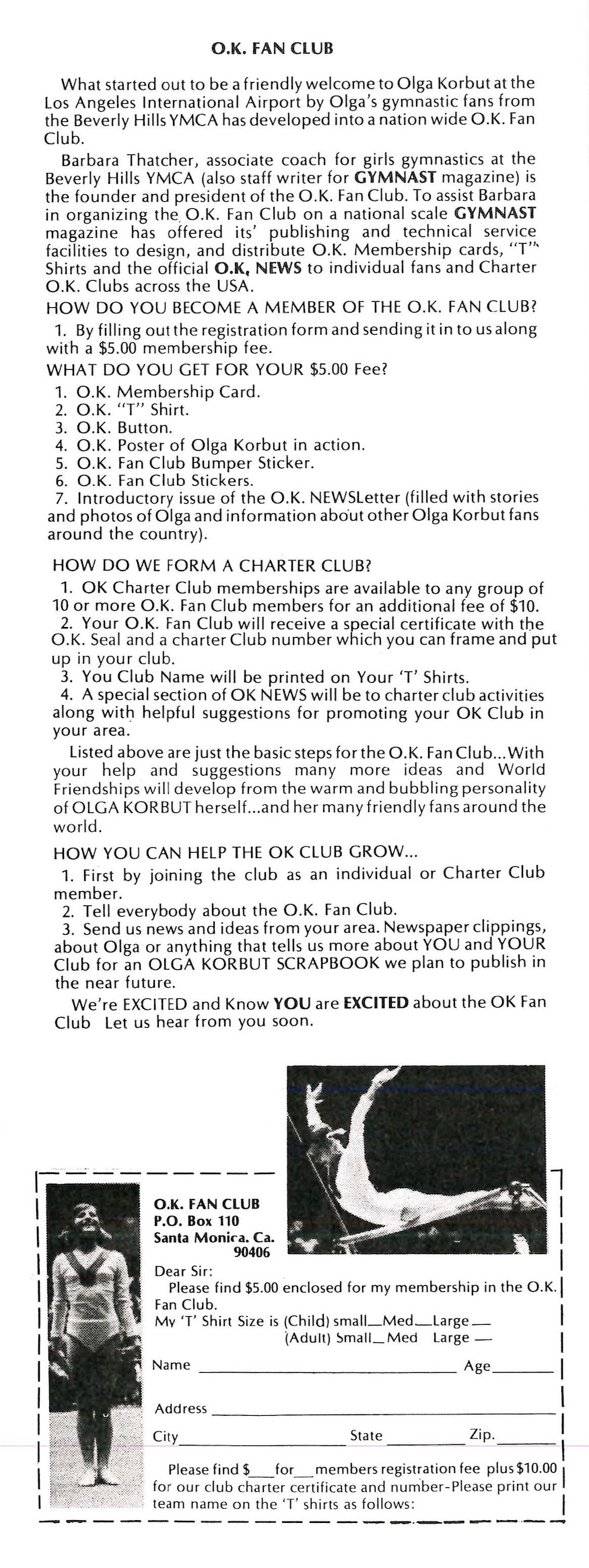
The U.S. Tour That Almost Wasn’t
In early 1973, the Soviet gymnasts toured the United States, but those exhibitions almost didn’t happen because Olga Korbut didn’t want to go. Still, the contract stipulated that Korbut had to perform. Here’s what Korbut writes in her autobiography:
The measured rhythm of our training was suddenly interrupted by the specter of Larisa Latynina, who appeared in our gymnasium one day in 1973.
“Pack your travel bags, folks!” she said cheerfully. “The plane to the United States of America leaves tomorrow.”
Ren and I looked at each other.
“But–” he started.
“No ‘buts’ accepted,” Latynina said, pretending to be hearty. “They have invited the National Team, but on one condition: that Korbut be on the list. So, don’t waste time, pack your suitcases. We’re leaving for Moscow today.”
So, how about that? The senior coach of the National Team had come personally to invite a gymnast whom she did not even consider as one of the team leaders. It was very hard for me to understand the motivations and intrigues of the Moscow authorities, although it was perfectly in keeping with what had happened when the team had been ordered to take another tour of West Germany. As usual, Ren was not invited to come along, and I decided to refuse, too.
“I won’t go,” I told Latynina.
Her smile was jovial, and pitiless. “You will, my dear. You have no alternatives.”
I ended up hiding in a restroom at the Sheremetevo Airport, crying in a stall. No one could find me, and the leaders of the National Team were in a complete uproar. Several times, I heard Latynina’s voice come over the PA system, demanding that I return to the team immediately. I didn’t, and the plane took off without me.
A day later, the team was back in Moscow, everybody angry and offended. The Germans had refused to receive the team, saying, “We are sorry, dear ladies, but we invited Korbut.”
Fabergé, the company that organized the twenty-day tour of the United States, had laid down the same condition. So Larisa Latynina had to come in person to Grodno to fetch a very stubborn young gymnast. In those days, I wasn’t even aware that every single exhibition tour contract the National Team received had a separate line in it, stipulating my mandatory participation.
My Story
Soviet Gymnasts Tour the U.S.
You can see the TV coverage of an exhibition in Houston, TX, here:
While this post is about Korbut, we have to take a moment to recognize Bogdanova’s double full off bars during the exhibition:
Sports Illustrated, like many publications, covered the Soviet tour. Here’s an excerpt from their article, which includes details about the contract:
Now the Russian women’s gymnastic team is on a two-week tour of seven U.S. cities—Houston, Buffalo, Los Angeles, Miami, Philadelphia, Washington and New York—and there is no question but that it was little Olga who brought them here. There are six girls altogether, and at least two of them, Ludmilla Turishcheva and Tamara Lazakovich, are generally considered more accomplished all-around gymnasts than Korbut. But without Korbut there would be no tour. It says so right in the contract—a document involving the AAU, the U.S. Gymnastic Federation, its Russian counterpart and the cosmetic firm Fabergé, which manages the tour and will underwrite any losses in the interest of sport and publicity. (“Anything that will make people sweat more,” said one tired promoter.)
In New York, where they touched down, Olga talked zestfully to the press. She is proud of her English, but her leaders usually insist that she converse through an interpreter. No, she has no boyfriends. Yes, she has studied English for three years. No, this is not the first time she has received roses (“They were in the dustbin in Munich”). Her parents’ instructions? “Be careful, be first, be joyful.” During the next leg of the trip, to Houston, she sashays twice down the aisle of the plane in her shocking-pink sweater enjoying the stares. From her bulging flight bag hangs an object with a mass of violet hair. It is apparently a hedgehog, and Olga carries it, she says, because it smells of candy. At Houston airport, all the girls are presented with Stetsons. Delighted, they put them on at once, but only Olga gets the angle right—straight down almost to the eyes.
Fabergé people had put together a program of cultural diversions and amusements for the girls. On presenting it to the Soviet team, they received some shocks. Through his pretty interpreter, Leader Vladimir Smolevsky said nyet to everything. No lunches, no dinners, no tours. Instead, could they please have a sauna and a place to work out now? The AAU man rustled up a local gym, but no one could find a free sauna.
Negotiations continued, with the Russians patiently but adamantly winning every point. The next stop would be Buffalo. Surely the girls should see Niagara Falls. “We will see Niagara Falls if there is no sauna,” said Smolevsky.
In short, Fabergé had just encountered the small, closed world of Russian gymnastics, where discipline reigns uncontested. Despite the fact that the girls were ashen with fatigue, Smolevsky explained: “Training is the best way to recover. The most helpful thing is active rest.”
His charges would not quarrel with that. They need the gym the way fish need water and, once there, they can no more be reached than trout in a deep pool. Going about regimens that seem to spring from private need or inspiration, they ignore photographers, attendants, other athletes and even some male groupies who try to attach themselves to their entourage.
In the beginning of a workout there is some horseplay—always with 85-pound Olga in the middle. Two teammates swing her like a jump rope. She does a stag leap into another’s arms, mocking the bravura end of classical ballet pas de deux. Then all the girls lose themselves in dodge ball.
Gradually they separate. Turishcheva, the best athlete and acknowledged group leader, may spend an hour in trancelike motion on the high, four-inch balance beam. Lazakovich, the most musical, traces and retraces her floor exercises. The younger girls are slightly more volatile: Rusudan Sikharulidze, a fiery Georgian; Luba Bogdanova, a daring girl with a loping stride who has not yet quite found her own style; Antonina Koshel, miserable because she has hurt her elbow slightly.
Soon they are unaware even of each other. But who are the three men hanging around on the sidelines staring at the ceiling, counting the empty house? They might be security guards, but they are in fact three of Russia’s most famous gymnastic coaches. The three top girls travel with their own coaches, who each also superintends one younger girl during the trip.
At first the noncommunication between coach and pupil seems comical. In the U.S., coaches are constantly underfoot, encouraging or criticizing their charges, “spotting” them—standing ready to catch them—on risky high maneuvers. The Russians look at things differently. Says Vikenty Dimitryev, who coaches Lazakovich, “The relationship is so close that a gesture is usually enough to correct a flaw. This approach makes the gymnast independent, as she must be in competition.” He adds that in general it is harder to coach women than men. “They get frustrated more quickly,” he sighs. “They like to be loved, to be admired.”
Korbut’s mentor, Renald Knysh, is the most unfathomable of an inscrutable lot. But between him and Olga there is animal communication. Sometimes they stare at each other from a distance like two cats; then Knysh may turn his back. But their gymnastics are mental as well. They are the two greatest innovators in the sport. “Olga’s spectacular moves have evolved slowly,” says Knysh. “The relation of the coach and the athlete is very prickly. There is a lot of tension.” Knysh knows exactly what he is aiming at. “I am not interested in gold medals. Judges are usually slow in accepting innovation. What I am concerned with is how spectators react to Olga and I try to get her to think the same way.” He does not add that the judges will follow, but in fact they usually do. In Munich, Korbut’s marks soared after the audience booed her first day’s scores.
There has been no time yet to develop a new move, but the famous back-flip is even more electrifying and technically perfect than at the Olympics. Since then she has received thousands of letters, some of them addressed to “Olga, Moscow,” but she insists that she does not feel like a celebrity.
“Hello to a Russian Pixie,” Martha Duffy, Sports Illustrated, March 19, 1973
Read the rest here:
https://vault.si.com/vault/1973/03/19/hello-to-a-russian-pixie
Gymnast magazine also covered the exhibition, and the writer criticized Korbut’s beam composition:
Korbut’s beam routine was much the same as the one in Munich. She added another tucked back flip to her routine, which does not really enhance the composition. Nowhere in her routine does she do walkovers or cartwheels in succession, nor does she perform any one arm skills. Her only dance movements are leaps and her routine lacks any of the intricate dance skills and turns for which other Russian performers are known.
The beam routine of Lazakovich however was much the opposite. Her dance elements were very graceful with a nice jump, full turn, chasse and side movements. Her tumbling skills included a back handspring and dive cartwheel.
Gymnast, March 1973
Soviet Gymnasts at the White House
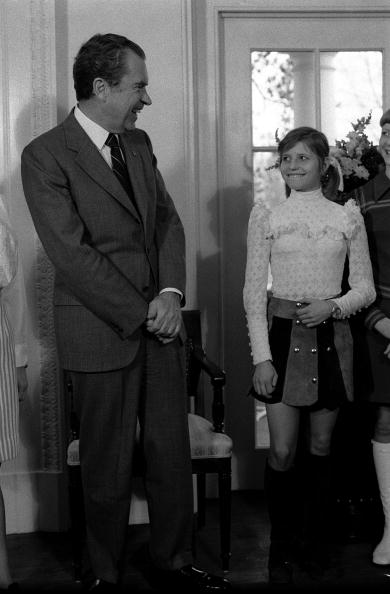
During their tour of the United States, the Soviet team went to the White House, where Korbut and Nixon had a funny exchange. Here’s how Korbut recalls the event:
In the middle of the American tour, we went to Washington, DC. On the first day, our morning training session was canceled for some reason. I was very upset because I felt I needed every second of that practice time.
“At 11:00,” our leader announced, “our delegation will be received by Richard Nixon.”
“What’s going on?” I asked Ren grumpily. “Couldn’t that Nixon fellow come for an autograph himself? I need to train!”
Ren laughed. “Richard Nixon isn’t an autograph seeker, Olga. He doesn’t give a damn about your signature. He’s the President of this country — the biggest shot here. He just wants to meet you, and have a chat.”
I was somewhat appeased, though angry at our practice being canceled so unceremoniously. I was still the little girl who had been snatched out of the fourth grade and whose knowledge of the world around me extended only to the local gymnasiums and hotels. In all honesty, I didn’t really know who Nixon was. The only literature I had ever read were textbooks focusing, for the most part, on the Soviet Union and the Communist Party, and those parts of newspapers that reported our exhibitions. My real education only began after I quit gymnastics for good.
When it was explained to me that the President ordinarily did not receive sports delegations, and our visit to the White House was an extraordinarily important and solemn event, I started to get nervous.
A large crowd of reporters was waiting for us. We were taken inside and given a twenty-minute tour of the Chief Executive’s mansion. I listened to the presentations being given by the friendly guides, and tapped my foot impatiently. When would he come, this Nixon, the number-one man in America? I could not understand why he should invite us, and then not bother to show up.
Suddenly, a tall, wide-shouldered and smiling man cut through the crowd of reporters. Was this the President? He looked like a nice enough guy. He came over to me, and I had to tilt my head up to look at him.
“Wow, what a little girl you are!” he said.
I forgot that I was not at home in Grodno, swapping insults with a boy from the next block, and my mouth opened before I could stop myself.
“Wow, what a big boy you are!” I replied perfectly mimicking his intonations.
My tongue has always been my enemy. How could I have said such a thing to the President of the United States? I was trying to think of a polite way out of the situation when all the Americans, including the “big boy,” burst into laughter. I was greatly relieved, and started laughing myself, pretending that the remark was one I had carefully planned and not simply a foolish blunder.
My Story
Soviet Gymnasts in London
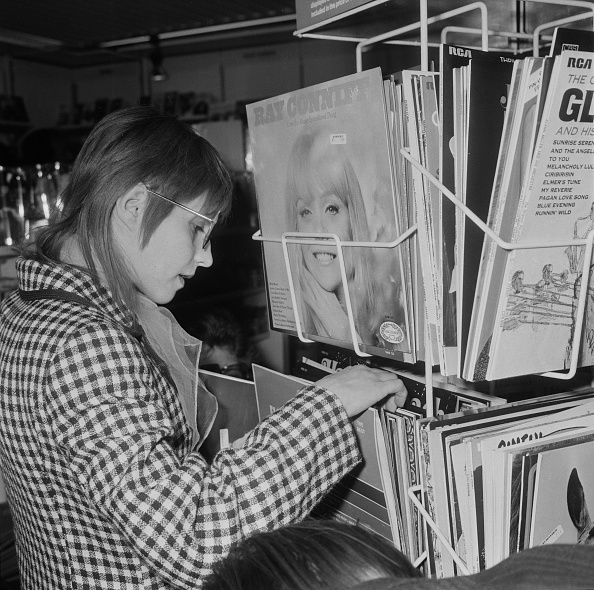
The Soviet gymnasts did not get a break. After the U.S. tour in March, they headed to England in May of 1973, where they did another exhibition. You can see Korbut’s floor routine here:
Here’s what Izvestia, one of the main Russian newspapers, wrote about the tour:
QUEENS, PRESIDENTS AND FOOTBALL
Calm, fragrant with spring and its nightingale songs and lulling rains, London seemed to return to the hot and hectic football fever of July of 1966. Several events excited English sports fans at the same time. First of all, of course, the final of the FA Cup at the Wembley Stadium with its 100,000 audience capacity, which recently celebrated its 50th anniversary. Then came the 37th Congress of the World Sports Press Association, where for the first time in the association’s half century of activity, an Englishman was elected president. Finally, the sport emotions reached their top the moment as the news had arrived – the Soviet gymnasts had come to London.
“Now we have several queens more,” said a smiling Frank Taylor, a well-known English sports journalist and columnist for the Daily Mirror. Sure, it added some work, but this work is delightful! I tell you, only in 1966 it was as difficult to get tickets for the final match of the world championship as today for the performances of Soviet gymnasts, among whom are such lovely athletes – the queens of grace and charm Olga Korbut, Ludmila Tourischeva, and Elvira Saadi.
The interest towards the demonstration performances of Soviet gymnasts in London can’t be described by the words “big” or “huge.” It is unprecedented. The multi-meter billboards flash with “Olga is in London!” signs. Within three days, Soviet gymnasts performed five times in front of the British audience.
Soviet athletes in London received a truly unusual reception. Television filmed and broadcast even their training sessions. Photojournalists used hundreds of film rolls, without leaving our gymnasts alone neither during competitions nor during their short pauses for rest. The Sunday People, a subsidiary of The Daily Mirror newspaper, conducted a survey among fourteen million British – they named Olga Korbut the world’s top athlete. At this meeting, the Soviet gymnast received a memorable prize. No need to say – all this is very delightful.
Even football commentators didn’t stay silent about Olga. One of the TV companies invited a group of our gymnasts, including Olga Korbut, to the FA Cup final, which took place on May 5 at Wembley. Commentators talked with Soviet gymnasts, asking their opinion even about football.
I must say that the final was magnificent. The team of the major league Leeds United played against Sunderland from the second league. Leeds United lost with a 0-1 score. The journalists counted that for the first time in the Cup final, one hundred thousand spectators paid 233,800 pounds for a single goal scored. Wembley has never had such a box office. I think Leeds United lost because everyone thought they were stronger than Sunderland. So did the Leeds players. What we saw was a black cat (the Sunderland club emblem) which ran across the road of the arrogant and self-confident Leeds in the final.
КОРОЛЕВЫ, ПРЕЗИЦЕНТЫ И ФУТБОЛ
Спокойный, благоухающий весной с ночными соловьиными третями и дневными убаюкивающими грибными дождями Лондон словно вернулся в жаркий и суматошный футбольный июль 1966 года. Сразу несколько событий взбудоражили английских любителей спорта. Прежде всего, конечно, финал Кубка Англии по футболу на стотысячном «Уэмбли», который в эти дни отмечал свое 50-летие. Затем 37-й конгресс Всемирной ассоциации спортивной прессы, где впервые за полвека деятельности этой ассоциации президентом был избран англичанин. И, наконец, своего апогея спортивные страсти достигли, как только стало известно, что в Лондон прилетели советские гимнасты.
— У нас стало на несколько королев больше,— с улыбкой заметил известный английский спортивный журналист, обозреватель газеты .Дейли миррор» Фрэнк Тейлор,— Правда, это прибавило хлопот, но они, право, очень приятны. Могу сказать, что разве только в 1966 году так же трудно было приобрести билеты на финальный матч первенства мира, как сегодня на выступления советских гимнастов, среди которых есть очаровательные спортсменки — королевы грации и обаяния Ольга Корбут, Людмила Турищева, Эльвира Саади.
Интерес к показательным выступлениям советских гимнастов в Лондоне трудно определить одним словом — «большой» или «огромный». Интерес — небывалый. На многометровых рекламных щитах броские надписи: «Ольга в Лондоне!» В течение трех дней советские гимнасты пять раз выступили перед англичанами.
Советским спортсменам в Лондоне устроили действительно необычный прием. Телевидение снимало и транслировало даже тренировки. Фоторепортеры отщелкали километры пленки, ни на минуту че оставляя в покое наших гимнастов и во время соревнований, и в короткие часы их отдыха. Газета «Санди пипл» — дочернее издание «Дейли миррор», провела опрос среди четырнадцати миллионов англичан, которые назвали первой спортсменкой мира Ольгу Корбут. На этой встрече советской гимнастке и был вручен памятный приз. Все это, конечно, очень приятно.
Ольгу Корбут не обошли своим вниманием даже футбольные комментаторы. Одна из телевизионных компаний пригласила группу наших гимнасток, в том числе и Ольгу Корбут, на финальный мап Кубка Англии, который состоялся 5 мая на «Уэмбли». Комментаторы беседовали с советскими гимнастками, интересуясь даже и их мнением о футболе.
Надо сказать, что великолепен был финал, в котором команда высшей лиги «Лидс Юнайтед» встретилась с клубом «Сандерленд» из второй лиги. Проиграл «Лидс Юнайтед»—0:1. Как отметили журналисты, впервые в финале Кубка сто тысяч зрителей заплатили за единственный забитый мяч 233.800 фунтов стерлингов. Таких сборов на «Уэмбли» еще не бывало. На мой взгляд, «Лидс Юнайтед» проиграл потому, что все считали эту команду сильнее «Сандерленда». Так думали и игроки «Лидса». А случилось, что черная кошка (это эмблема клуба «Сандерленд».— Б. Ф.) перебежала в финале дорогу самонадеянному и самоуверенному «Лидсу».
Izvestiia, No. 109, May 11, 1973
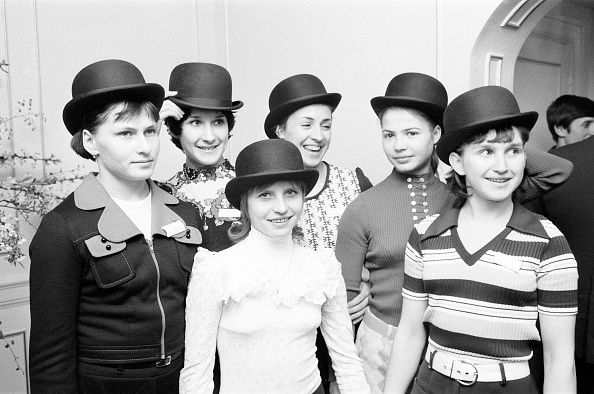
⁂ ⁂ ⁂
The Soviet Union was stricken by its own form of Korbut mania, which will be the subject of the next post.
More on 1973
2 replies on “1973: Olga Korbut Mania”
Fantastic post! Thank you once again!
Thanks for doing all this job! I will be happy to share some materials as a historian of sports (and gymnastics in particular) if you are interested. I am also a native speaker of Russian. Please reach out to me via e-mail or on FB. Thanks again!